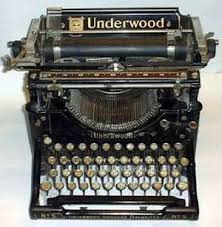Like many inventions of genuine import, the typewriter has many parents.
An article on the subject at Wikipedia gives a litany of advances toward the development of a mechanical writing machine. As early as 1575 an Italian printmaker named Francesco Rampazzetto invented something he called the “scripture tattle,” which impressed letters onto paper. Then in 1714 an Englishman Henry Mill received a patent for something very much like a typewriter. Although nothing seemed to come of it. The development of the machine really took off in the nineteenth century. Three Italians developed typewriters, Agostina Fantoni in 1802, Pellegrino Turri in 1808, he also figured out carbon paper, and Pietro Conti di Cilavegna in 1823.
In 1829 an American William Austin Burt developed a typewriter and received a patent. Sometimes he is credited as the inventor, although clearly he wasn’t the first. Worse yet, his machine was extremely cumbersome, and operators could not type faster than someone could write by hand.
The list starts getting crowed from here, with various inventors developing machines that could write.
But, then, it was on this day in 1868 that three American inventors, Christopher Latham Sholes, Carlos Glidden, and Samuel W Soule received a patent for a working machine, which is generally credited as the direct ancestor of the typewriter in production from the second half of the nineteenth century and continued until it was largely overtaken by computers at the end of the twentieth century. This machine was the first to use the QWERTY key layout. And, most important, while it still had more than a few problems, it really worked.
Christopher Sholes was the principal developer of the machine. In what was probably a singularly bad professional move, Samuel Soule soon left the partnership to be replaced by James Densmore, who had the requisite deep pockets to allow them to continue the development of the machine. Still, it didn’t become a generally available office machine until it was acquired by the Remington company in 1873.
All this said today marks the beginning of a working machine, the one that gives us the keyboard, for good and ill, we use on our computers today.
This is a freaking big deal. No doubt, a revolution began quietly on this day, one hundred and forty-seven years ago. Well, quiet in its beginnings…
And so, happy birthday to the Sholes-Glidden typewriter, from a grateful inheritor of the mechanical and now electronic writing machine!
Songs should be sung. Parades marched. Bottles of bubbly opened.
Or, at least, a small symphony should be played…













